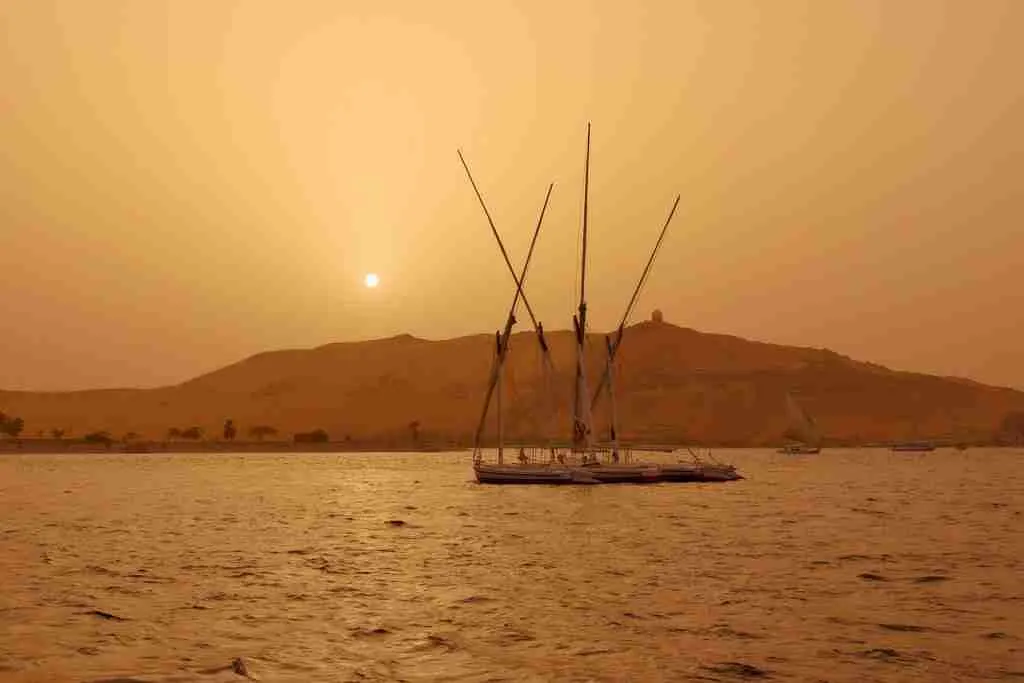24 Facts About The Nile River (You Must Know)
-
The Nile’s course has been stable for 30 million years due to a mantle plume.
-
White water rafting is popular on the Nile’s rapids in Uganda.
-
The Rosetta Stone was discovered near the Nile River in 1799.
-
A journalist walked the entire length of the Nile in 2013, taking nine months.
-
The Atbara River is a significant tributary joining the Nile from Ethiopia.
-
The first Aswan dam was completed in 1902 to control flooding.
-
Ancient Egyptians worshipped Hapi, the god of the Nile’s inundation.
-
Ancient Egyptians created a calendar based on the Nile’s predictable flooding.
-
The Nile sustains over 400 million people across its basin countries.
-
Egypt relies on the Nile for 97% of its freshwater supply.
-
The Aswan High Dam generates significant hydroelectric power for Egypt.
-
The Nile Delta produces a large share of Egypt’s agricultural output.
-
International cooperation is crucial for managing the Nile’s waters among 11 countries.
-
The Nile has been a cradle of civilization for millennia, shaping ancient Egypt.
-
Climate change threatens the Nile with altered flow patterns and droughts.
Table of Contents
1. The Nile is the longest river in the world.
The Nile River holds the title for being the longest river on Earth, stretching approximately 6,650 kilometers (4,132 miles). This remarkable length has made it a subject of fascination and study for centuries, and it’s one of the key Facts About The Nile River that stands out.
Despite some debates about whether the Amazon River might be longer, the Nile’s length is officially recognized by many geographical authorities. Its vast expanse allows it to traverse diverse landscapes, from tropical rainforests to arid deserts, making it a lifeline for millions.
2. It flows through 11 countries.
The Nile River winds its way through 11 different countries in Africa, including Tanzania, Uganda, Rwanda, Burundi, the Democratic Republic of the Congo, Kenya, Ethiopia, Eritrea, South Sudan, Sudan, and Egypt. This makes it a transboundary river with significant geopolitical importance.
Each country along the Nile has its own relationship with the river, from being a source of water and food to a means of transportation and trade. The shared nature of the Nile often leads to cooperation and sometimes conflict over water rights and usage.
3. The Nile’s drainage basin covers about 10% of Africa.
The drainage basin of the Nile River encompasses approximately 3.3 million square kilometers, which is about 10% of the entire African continent. This vast area includes a wide range of ecosystems, from lush wetlands to dry savannas.
The basin’s size highlights the Nile’s critical role in the hydrology and ecology of Africa. It supports diverse flora and fauna and is essential for the livelihoods of millions of people who depend on its waters for agriculture, fishing, and domestic use.
4. The name Nile may have originated from the Greek word for River Valley (neilos).
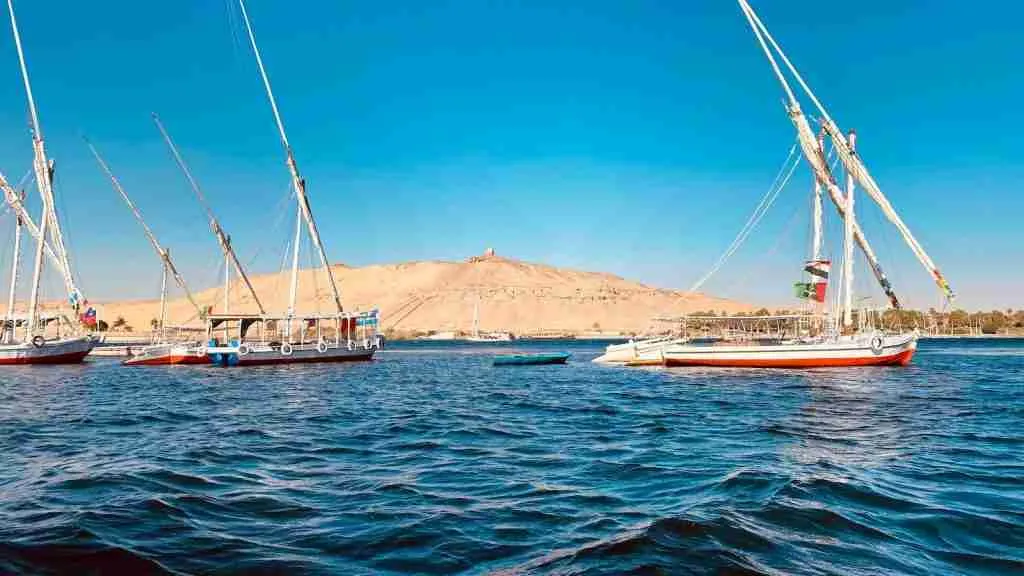
READ ALSO: 22 Fun Facts About Swimming You Must Know
The Nile River is one of Earth’s most prominent sources, renowned for its cultural, historical, and natural significance. The origin of its iconic name has been derived from Greek; the term nails refers to a river valley.
The length of this unique river has offered many opportunities throughout the years, making it an invaluable asset to the global community as a natural resource for life and vitality.
5. The Nile has two major tributaries.
The Nile River is formed by two major tributaries: the White Nile, which originates in South Sudan, and the Blue Nile, which begins in Ethiopia. These tributaries meet at Khartoum, Sudan, to form the main Nile River.
The White Nile is considered the longer branch, but the Blue Nile contributes most of the river’s water and silt. Together, they create a powerful flow that sustains life along the river’s course.
6. The Nile flows northward from its sources.
Unlike most rivers that flow from north to south, the Nile flows northward from its sources in the African Great Lakes to the Mediterranean Sea. This unique flow direction is one of the intriguing Facts About The Nile River.
The northward flow is due to the tilt of the Earth and the way water flows from higher to lower elevations. This characteristic has influenced the climate and geography of the regions it passes through, creating fertile lands along its banks.
7. The Nile was crucial for ancient Egyptian civilization.
The Nile River was the lifeblood of ancient Egypt, providing water for irrigation, fertile soil for farming, and a means of transportation. Its annual flooding deposited rich silt, making the land around it incredibly productive.
Ancient Egyptians revered the Nile as a gift from the gods, with festivals and rituals dedicated to its flooding. The river also enabled trade and communication between different regions of Egypt, helping to unify the kingdom.
8. Over 250 species of birds live along the banks of the Nile River.
When it comes to the biodiversity of the Nile River, there are many fascinating facts to uncover. For example, did you know that the Nile is home to over 250 bird species on its banks and marshes?
This diverse range of bird life. In particular, the painted snipe, an exotic breed that is almost extinct elsewhere in the world, has made the River Nile its roaming grounds.
Songbirds from reed warblers to crakes, hoot owls, and bee-eaters flock to this grand river valley, making it a wonderful spectacle.
9. Ancient Egyptians used to mummify crocodiles, which they considered sacred animals.
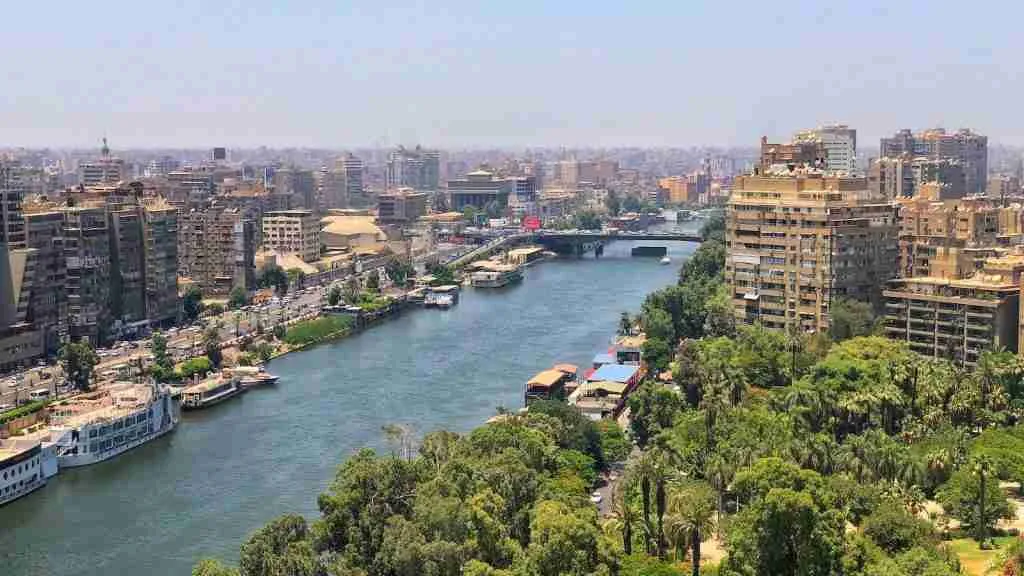
READ ALSO: 27 Facts About The Amazon River (Let’s Dive In)
The Ancient Egyptians worshipped the crocodile, a sacred animal. They preserved their dead through mummification and placed them in Tombs close to the Nile River.
This practice extended beyond royalty; Kings and Queens were often buried beside cretaceous creatures intact. In numerous cases, several remains were found in the same vicinity –giving archaeologists an opportunity to witness a glimpse fashion of ancient spiritual practices.
10. The Nile Delta is one of the world’s largest.
The Nile Delta, where the river meets the Mediterranean Sea, is one of the largest river deltas in the world, stretching about 100 miles long and 150 miles wide. It’s a fertile region that has supported agriculture for millennia.
The delta’s rich soil has made it a hub for farming, but it’s also vulnerable to environmental changes like rising sea levels. Historically, it was a key area for ancient Egyptian settlements and trade.
11. The Aswan High Dam controls the Nile’s flooding.
Built in the 1960s, the Aswan High Dam regulates the Nile’s flow, preventing devastating floods and providing hydroelectric power. It created Lake Nasser, one of the world’s largest artificial lakes.
While the dam has brought benefits like consistent water supply and electricity, it has also led to challenges such as soil salinization and reduced fertility downstream. It remains a symbol of modern engineering but also of environmental trade-offs.
12. Pharaohs often built Temples and Monuments near the Nile River in order to Honor their Gods.
READ ALSO: 27 Facts About the Ganges River (Let’s Dive In)
For centuries, Pharaohs have sought to erect impressive Temples and imposing Monuments close to the Nile to show their reverence and honor their Gods.
These sacred sites served as symbols of faithfulness and served as testaments to the Pharaohs’ unwavering devotion to their deities.
13. The Nile is home to diverse wildlife.
The Nile River supports a variety of wildlife, including crocodiles, hippos, and numerous bird species. Its waters and surrounding wetlands are critical habitats for these animals.
However, human activities like dam construction and pollution have threatened some species. Conservation efforts are underway to protect the Nile’s unique biodiversity for future generations.
14. The Nile has been a source of conflict over water rights.
As a transboundary river, the Nile has often been at the center of disputes between countries like Egypt, Sudan, and Ethiopia over water usage and dam construction. These conflicts highlight the river’s strategic importance.
International agreements and negotiations are ongoing to ensure fair distribution of the Nile’s waters. The river’s role as a shared resource underscores the need for cooperation among nations.
15. The source of the Nile was a mystery for centuries.
For centuries, explorers like David Livingstone and Henry Morton Stanley searched for the Nile’s source, which was finally identified as Lake Victoria in Uganda. This quest captivated adventurers and geographers alike.
The discovery of the source in 1858 by John Hanning Speke marked a significant moment in exploration history. It also highlighted the river’s complex network of tributaries and lakes.
16. The River Nile holds religious importance for many religions.
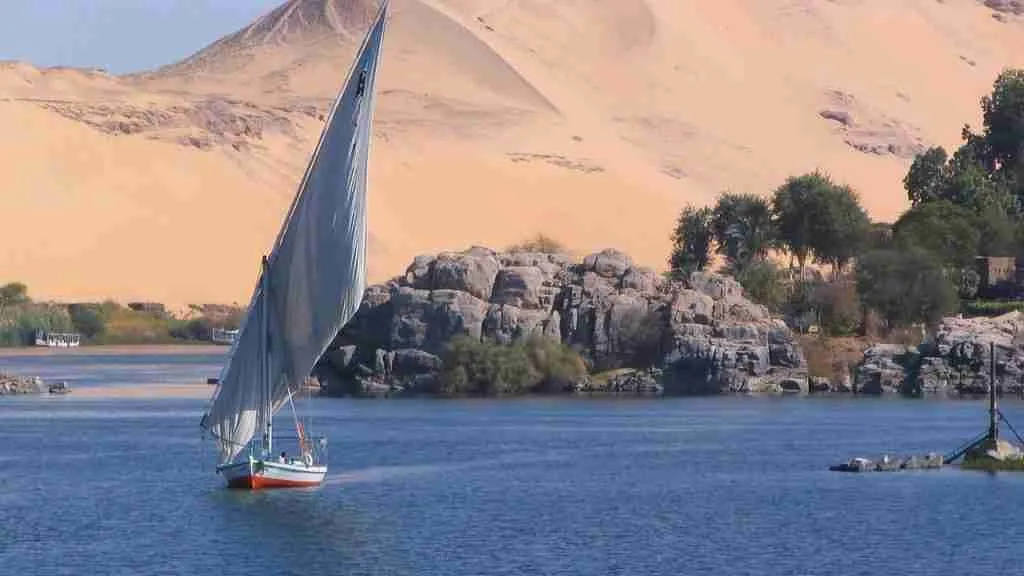
READ ALSO: 23 Fun Facts About the Missouri River (Missouri Marvels)
Predominantly an important feature in Christianity, multiple embarkation scenes aboard ships are narrated on The Nile, notably when Abraham had to sail away with his family.
Another important religious narration involving the River Nile is about the Prophet Moses, who was a leader who faced many tribulations during his lifetime.
As an infant, he found himself discarded by the banks of the River Nile centuries ago. Having been separated from his family and without a home, it seemed his fears had manifested and powerless as he appeared, washed up on its edges.
17. The Nile Valley is densely populated.
The Nile Valley is one of Africa’s most densely populated regions, with millions of people relying on the river for water and food. Cities like Cairo and Khartoum have grown along its banks.
The river’s fertile lands have supported agriculture for thousands of years, but rapid population growth has put pressure on these resources. Sustainable management of the Nile is crucial for future generations.
18. The Nile is navigable for much of its length.
The Nile has been a vital transportation route for millennia, allowing goods and people to travel from one region to another. Its calm waters made it ideal for trade and exploration.
In ancient times, boats carried everything from grain to stone blocks for pyramids. Today, modern vessels continue to use the Nile for commerce and tourism.
19. Ancient Egyptians developed advanced irrigation systems.
Ancient Egyptians built complex irrigation systems, including canals and basins, to harness the Nile’s waters for farming. These systems allowed them to grow crops like wheat and flax even during dry seasons.
The shaduf, a simple but effective tool for lifting water, was a key innovation. These techniques laid the foundation for modern irrigation practices along the Nile.
20. The Nile played a role in ancient Egyptian religion.
The Nile was deeply intertwined with ancient Egyptian religion, with gods like Hapi associated with its flooding. The river’s annual cycle was seen as a divine gift that ensured prosperity.
Rituals and festivals celebrated the Nile’s rise, and temples were often built near its banks. The river’s life-giving properties were central to Egyptian beliefs about rebirth and eternity.
21. Pharaohs were believed to be sent on the Nile in boats posthumously to reach their afterlife in the heavens.
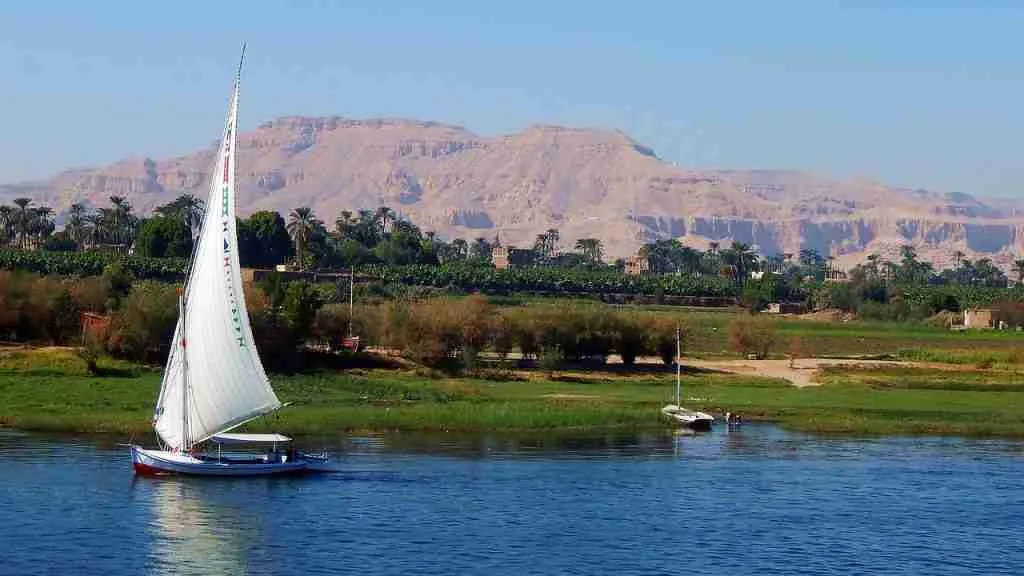
READ ALSO: 20 Interesting Facts About Mount Elbrus | You Won’t Believe
For centuries, the Pharaohs of Ancient Egypt believed they would continue their journey even in death. Therefore, when a Pharaoh passed away, he was sent down the sacred Nile River in a boat.
With an eye skyward and pointing back at the world of mortals left behind, the vessel descended into the stars.
22. The Nile supports cotton and other crops in Egypt.
In Egypt, the Nile irrigates vast fields of cotton, wheat, and vegetables, making it a cornerstone of the country’s economy. The river’s waters are carefully managed to maximize agricultural output.
However, overuse of water for farming has led to concerns about sustainability. Balancing agriculture with conservation is a key challenge for Egypt’s future.
23. The Nile Crocodile is one of its most famous residents.
The Nile Crocodile is one of the largest crocodile species in the world and is found throughout the river. It’s both feared and revered in local cultures.
While crocodiles are a natural part of the ecosystem, they can also pose dangers to humans. Conservation efforts aim to protect these ancient creatures while ensuring safety.
24. The Nile is mentioned in ancient texts like the Bible and Quran.
The Nile River is referenced in religious texts like the Bible and Quran, often symbolizing life and divine providence. Its role in biblical stories like Moses’ infancy is well-known.
These references highlight the river’s spiritual significance across cultures. For many, the Nile remains a symbol of faith and endurance.
25. The Nile’s flow is relatively constant compared to other rivers.
Unlike rivers with heavy seasonal variations, the Nile has a relatively steady flow throughout the year. This stability has made it a reliable resource for agriculture and trade.
However, modern dams and climate change have altered its natural patterns. Monitoring these changes is essential for managing water resources.
26. The Grand Ethiopian Renaissance Dam is a modern controversy.
The Grand Ethiopian Renaissance Dam on the Blue Nile has sparked debates between Ethiopia and Egypt over water rights. Ethiopia sees it as a symbol of progress, while Egypt worries about reduced water flow.
Negotiations continue to balance development with downstream needs. The dam highlights the complex politics of shared water resources.
27. The Nile is a lifeline for desert regions.
In desert regions like Egypt and Sudan, the Nile is a rare source of greenery and life. Its waters transform arid landscapes into fertile oases.
This contrast between desert and river has shaped cultures and economies. The Nile’s role as a desert lifeline is unmatched.
FAQS
The Nile River starts at Lake Victoria in Uganda and ends in the Mediterranean Sea in Egypt. Its journey begins in the African Great Lakes region and flows northward through diverse landscapes. This path makes it a vital lifeline for millions across multiple countries.
The Nile River is located in northeastern Africa, spanning 11 countries. It flows from the highlands of central Africa to Egypt’s coastal delta. Its vast basin covers about 10% of the African continent.
The Nile flows through Tanzania, Uganda, Rwanda, Burundi, Democratic Republic of the Congo, Kenya, Ethiopia, Eritrea, South Sudan, Sudan, and Egypt. These nations rely on the river for water, agriculture, and energy. Its transboundary nature often sparks cooperation and disputes.
The Nile River is approximately 6,650 kilometers (4,132 miles) long. This makes it the longest river in the world, though some debate the Amazon’s length. Its vast length supports diverse ecosystems and human populations.
The Nile River is the longest river in the world, stretching over 4,000 miles through Africa. It helps grow food and supports animals like crocodiles and hippos. Kids can imagine it as a giant water highway for 11 countries!
The Nile River is about 30 million years old, based on geological studies. Its path has stayed stable due to Earth’s mantle activity. This makes it one of the oldest rivers still flowing today.
The Nile River’s depth varies, averaging 8–11 meters (26–36 feet) in most areas. Some parts, like near dams, can be deeper, up to 20 meters. Its depth supports boats and diverse aquatic life.

